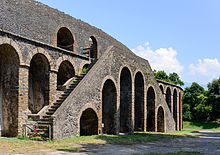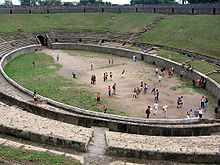|
Amphitheatre of Pompeii
The Amphitheatre of Pompeii is one of the oldest surviving Roman amphitheatres. It is located in the ancient city of Pompeii, near Naples, and was buried by the eruption of Mount Vesuvius in 79 AD, that also buried the city of Pompeii and the neighbouring town of Herculaneum. Six bodies were found during the excavations.[2] Design and construction Built around 70 BC, the amphitheatre is one of the earliest Roman amphitheatres built of stone; previously, they had been built out of wood.[3] Contemporarily, it was known as a spectacula rather than an amphitheatrum, since the latter term was not yet in use at the time. It was built with the private funds of Gaius Quinctius Valgus and Marcus Porcius (a relative of Cato the Younger). The space was constructed shortly after Pompeii's induction as a Roman colony, and an inscription on the amphitheatre honouring the donors, Gaius Quinctius Valgus and Marcus Porcius, cites one of their motives, being, "to demonstrate the honour of the colony," perhaps indicating the amphitheatre's role in establishing Roman influence in Pompeii.[4] The Amphitheatre was designed so it could fit upwards of 20,000 people.[5] The design is seen by some modern crowd control specialists as near-optimal. The design of the lower entrances for higher-class citizens, who would have been seated closest to the pit, have been noted for their facility in curating unique viewership experiences—viewers would be struck by both the beams of light flooding the dark tunnel and the roar of the crowd as they entered the amphitheatre, creating a highly stimulating and dramatic experience.[6] Being one of the earliest Amphitheatres made, there was no underground areas for the gladiators. Instead, the quadriporticus was built above ground and close to the arena. When events were done, the dead were taken through a large door named the Porta Libitinensis to leave the arena to be disposed of. [7] The amphitheatre measures 135m long and 104m wide. The arena is 6m below ground level and measures 66.7m long and 35.1m wide.[8] The only internal features of the amphitheatre at Pompeii were a corridor that cut into the base of cavea, the tiered semicircular seating space. This corridor ran the circumference of the amphitheatre and is used to access the arena.[9]  Gladiatorial contestsThe preservation of Pompeii and its amphitheatre have given insights into the gladiatorial culture of Rome. Painted posters on the walls of the amphitheatre have been uncovered depicting gladiators accompanied by slogans and nicknames, evoking shades of the modern posters, billboards, and banners depicting today's sports stars and celebrities. Some of the posters would be repainted over to state the outcomes of the major events.[10] For example, one poster declares a gladiator to be the "Heart throb of the girls."[4] A recovered fresco depicts the end of a fight, with the losing gladiator awaiting his fate.[11] One of the most notable events in the amphitheatre's history occurred around 59 AD, when a deadly brawl occurred between Pompeiians and residents of Nuceria during games in the amphitheatre, resulting in a 10-year ban on such events.[12] Some events like beast hunting and athletic competition were still allowed to take place. This may have been due to the intervention of empress Poppaea Sabina and a local magistrate.[13] EarthquakeThe amphitheatre was damaged by an earthquake in 62 AD. The magistrate Cuspius Pansa and his son undertook its restoration.[14] After its restoration, the 10-year ban on events was revoked.[15] Modern usesThe amphitheatre and the riot was portrayed in the Cambridge Latin Course in unit 1. Aside from being a historical landmark and an object of archaeological study, the amphitheatre has been used for concerts and other public events in modern times. Over a 4-day period in October 1971, Pink Floyd made a concert film at the amphitheatre, titled Pink Floyd: Live at Pompeii in which the band plays a typical live set but without any audience except for the film crew. David Gilmour, the band's guitarist, returned to perform two concerts at the amphitheatre in July 2016 as part of his Rattle That Lock Tour. Gilmour's 2016 concerts saw the first public performances in the amphitheatre since 79 AD[16] and are featured on the live album/video Live at Pompeii. In 2015 a temporary museum was installed in the centre of the amphitheatre. The pyramidal structure was designed to resemble Mount Vesuvius, and housed the installation "Pompeii and Europe from 1748 to 1943", which displayed casts of 20 victims of the eruption and photographs of the excavations. In 2018, the venue hosted a live performance to an audience by the English progressive rock group King Crimson. In 2023 the Venue was used as a filming location for rapper Travis Scott’s visual album Circus Maximus.
See alsoReferences
Bibliography
Further reading
External linksWikimedia Commons has media related to Amphitheatre of Pompeii. |
|||||||||||||||||||||||||||||||||||||||||||||||||||||||
